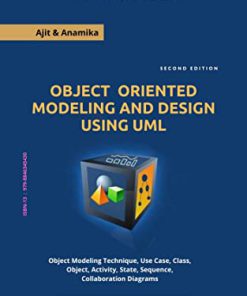Object Oriented Software Design in C++ MEAP 1st Edition by Ronald Mak ISBN 9781633439504 163343950X
$50.00 Original price was: $50.00.$25.00Current price is: $25.00.
Object Oriented Software Design in C++ MEAP 1st Edition by Ronald Mak – Ebook PDF Instant Download/Delivery: 9781633439504 ,163343950X
Full download Object Oriented Software Design in C++ MEAP 1st Edition after payment

Product details:
ISBN 10: 163343950X
ISBN 13: 9781633439504
Author: Ronald Mak
Object Oriented Software Design in C++ MEAP 1st Edition Table of contents:
Part 1. Introduction
1 The path to well-designed software
1.1 What is software design?
1.2 What you will learn from this book
1.3 The benefits of good software design
1.4 A few design examples
1.4.1 Leaking changes
1.4.2 Code that’s too complex
1.4.3 Inflexible code
1.4.4 Surprise!
1.4.5 Common architecture problems
1.5 Make sure we’re going to build the right application; then, build it right
1.6 Good design doesn’t come easily
1.7 Change and complexity are the enemies of good design
1.8 Design with object-oriented programming concepts
Summary
2 Iterate to achieve good design
2.1 Good application design requires an iterative process
2.2 Don’t let changes leak out
2.3 Iterate to achieve good design
2.3.1 Iteration 1: Initial cohesive classes
2.3.2 Iteration 2: Encapsulation, delegation, and loose coupling
2.3.3 Iteration 3: More kinds of books and their attributes
2.3.4 Iteration 4: A better design after backtracking
Summary
Part 2. Design the right application
3 Get requirements to build the right application
3.1 The overture to application design
3.2 Functional requirements: What must the application do?
3.3 Nonfunctional requirements: Constraints on the application
3.4 What are good requirements?
3.5 How to get requirements
3.5.1 A short requirements case study
3.5.2 Stated and implied requirements
3.6 Unified Modeling Language diagrams for creating and documenting design
3.7 Use cases provide context for the requirements
3.7.1 UML use case diagram
3.7.2 Use case description
3.8 The functional specification and software validation
3.9 Where do classes come from?
3.9.1 Textual analysis: Nouns can become classes
3.9.2 Textual analysis: Verbs can become member functions
Summary
4 Good class design to build the application right
4.1 When do we do application design?
4.2 Two important goals for good class design
4.2.1 Cohesion and the Single Responsibility Principle
4.2.2 Loose coupling and the Principle of Least Knowledge
4.3 UML class diagrams to document class design
4.4 Class relationships determine runtime interactions
4.4.1 Dependency: The most basic relationship
4.4.2 Aggregation and composition: Objects that contain other objects
4.4.3 Generalization: Superclasses and their subclasses
4.4.4 Abstract classes and interfaces: What subclasses must implement
4.5 UML state diagram: How an object changes state
4.6 UML sequence diagram: How objects interact [optional]
4.7 The design specification and software verification
Summary
Part 3. Design the application right
5 Hide class implementations
5.1 The Principle of Least Knowledge and hidden implementations
5.2 Public getter and setter functions access hidden implementation selectively
5.3 Class Date: An example of implementation hiding
5.3.1 Iteration 1: Date arithmetic with loops
5.3.2 Iteration 2: Julian day numbers simplify date arithmetic
5.3.3 Iteration 3: A hybrid approach with lazy evaluation
5.4 Public setter functions carefully modify hidden implementation
5.5 Beware of dangerous setter functions
5.6 Rules from the Law of Demeter
5.7 But is the implementation really hidden?
5.8 The Open-Closed Principle supports code stability
Summary
6 Don’t surprise your users
6.1 No surprises and the Principle of Least Astonishment
6.1.1 Off-by-one errors
6.1.2 Misnamed functions can mislead their callers
6.2 Poor performance is an unwelcome surprise
6.2.1 Bad design can cause unexpected performance problems
6.2.2 The vexatious performance of C++ vectors
6.3 Programming by Contract helps to eliminate surprises [optional]
6.3.1 Programming a circular buffer by contract
6.3.2 Precondition: What must be true before calling a function
6.3.3 Postcondition: What must be true after returning from a function
6.3.4 Class invariant: What must remain true of object states
Summary
7 Design subclasses right
7.1 When to use function overriding or overloading
7.1.1 Override superclass member functions to get subclass behavior
7.1.2 Overload functions that have similar or equivalent behaviors
7.2 The Liskov Substitution Principle and proper subclasses
7.3 Choosing the is-a and has-a relationships
7.4 Use a factory function with the Code to the Interface Principle
7.5 Programming by Contract with subclasses [optional]
Summary
Part 4. Design patterns solve application architecture problems
The benefits of design patterns
Explaining the design patterns
The sports examples
8 The Template Method and Strategy Design Patterns
8.1 The Template Method Design Pattern defines the steps of an algorithm
8.1.1 Desired design features
8.1.2 Before using the Template Method Design Pattern
8.1.3 After using the Template Method Design Pattern
8.1.4 Template Method’s generic model
8.2 The Strategy Design Pattern encapsulates algorithms
8.2.1 Desired design features
8.2.2 Before using the Strategy Design Pattern
8.2.3 After using the Strategy Design Pattern
8.2.4 Strategy’s generic model
8.3 Choose between Template Method and Strategy
Summary
9 The Factory Method and Abstract Factory Design Patterns
9.1 The Factory Method Design Pattern lets subclasses create objects
9.1.1 Desired design features
9.1.2 Before using the Factory Method Design Pattern
9.1.3 After using the Factory Method Design Pattern
9.1.4 Factory Method’s generic model
9.2 The Abstract Factory Design Pattern creates families of objects
9.2.1 Before using the Abstract Factory Design Pattern
9.2.2 After using the Abstract Factory Design Pattern
9.2.3 Abstract Factory’s generic model
Summary
10 The Adapter and Façade Design Patterns
10.1 The Adapter Design Pattern integrates code
10.1.1 Desired design features
10.1.2 Before using the Adapter Design Pattern
10.1.3 After using the Adapter Design Pattern
10.1.4 Adapter’s generic model
10.1.5 An alternative Adapter Design Pattern model
10.2 The Façade Design Pattern hides a subsystem of interfaces
10.2.1 Desired design features
10.2.2 Before using the Façade Design Pattern
10.2.3 After using the Façade Design Pattern
10.2.4 Façade’s generic model
Summary
11 The Iterator and Visitor Design Patterns
11.1 The Iterator Design Pattern encapsulates iterating over different sequential collections
11.1.1 Desired design features
11.1.2 Before using the Iterator Design Pattern
11.1.3 After using the Iterator Design Pattern
11.1.4 Iterator’s generic model
11.2 The Visitor Design Pattern encapsulates different algorithms that operate on a data collection
11.2.1 Desired design features
11.2.2 Before using the Visitor Design Pattern
11.3 After using the Visitor Design Pattern
11.3.1 Visitor’s generic model
Summary
12 The Observer Design Pattern
12.1 The Observer Design Pattern represents the publisher–subscriber model
12.1.1 Desired design features
12.1.2 Before using the Observer Design Pattern
12.1.3 After using the Observer Design Pattern
12.1.4 The Observer’s generic model
Summary
13 The State Design Pattern
13.1 The State Design Pattern models state transitions
13.1.1 Desired design features
13.1.2 Before using the State Design Pattern
13.1.3 After using the State Design Pattern
13.1.4 State’s generic model
Summary
14 The Singleton, Composite, and Decorator Design Patterns
14.1 The Singleton Design Pattern ensures a class has only one object
14.1.1 Desired design features
14.1.2 Before using the Singleton Design Pattern
14.1.3 After using the Singleton Design Pattern
14.1.4 Singleton’s generic model
14.2 The Composite Design Pattern treats individual and composite objects uniformly
14.2.1 Desired design features
14.2.2 Before using the Composite Design Pattern
14.2.3 After using the Composite Design Pattern
14.2.4 Composite’s generic model
14.3 The Decorator Design Pattern dynamically adds object responsibilities
14.3.1 Desired design features
14.3.2 Before using the Decorator Design Pattern
14.3.3 After using the Decorator Design Pattern
14.3.4 Decorator’s generic model
Summary
Part 5. Additional Design Techniques
15 Designing solutions with recursion and backtracking
15.1 Recursion compared to the for loop
15.2 Finding the largest value by recursion
15.3 Reversing a vector by recursion
15.4 Solve the Towers of Hanoi puzzle by recursion
15.5 Recursive algorithms for a binary search tree
15.5.1 Inserting into a BST with recursion
15.5.2 Printing a BST with recursion
15.5.3 Removing all the nodes of a BST with recursion
15.6 Quicksort an array with recursion
15.6.1 Quicksort in action
15.6.2 Partitioning an array into subarrays
15.6.3 Quicksort implementation
15.7 The Fibonacci sequence and a recursion disaster
15.8 Dynamic backtracking increases the power of recursion
15.9 Solving the eight queens puzzle with recursion and backtracking
15.10 Solving Sudoku puzzles with recursion and backtracking
Summary
16 Designing multithreaded programs
16.1 How do things happen simultaneously?
16.2 A mutex enforces mutual exclusion
16.2.1 Protect the integrity of a shared resource
16.2.2 The classic reader–writer problem
16.3 Condition variables synchronize threads
16.3.1 How condition variables synchronize threads
16.3.2 The classic producer–consumer problem
16.4 A final note on multithreading
Summary
index
People also search for Object Oriented Software Design in C++ MEAP 1st Edition:
what is object oriented design in software engineering
what is object oriented design
object oriented design software
object oriented design in c
object-oriented data structures in c++
Tags: Ronald Mak, Object Oriented, Software Design, C++
You may also like…
Computers - Programming
Computers - Programming
Computers - Programming
Computers - Programming
Grokking the Object Oriented Design Interview 1st Edition by Educative.Io
Computers - Programming
Computers - Programming
Computers - Programming
Computers - Programming











